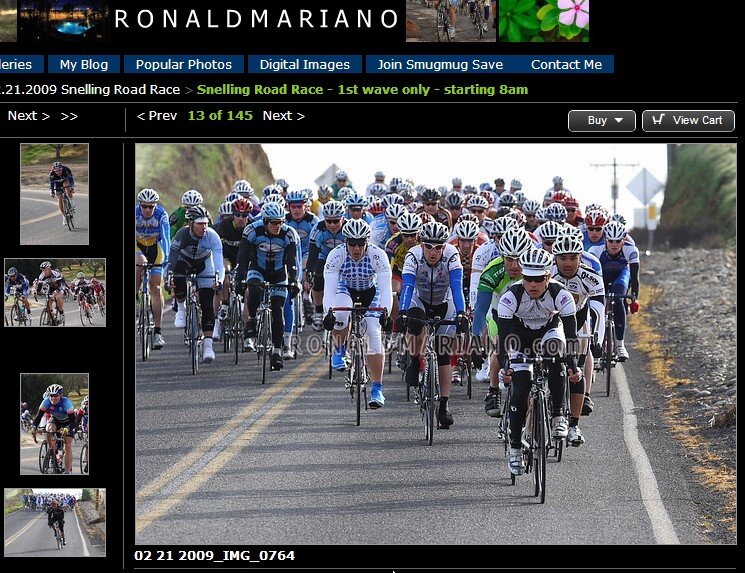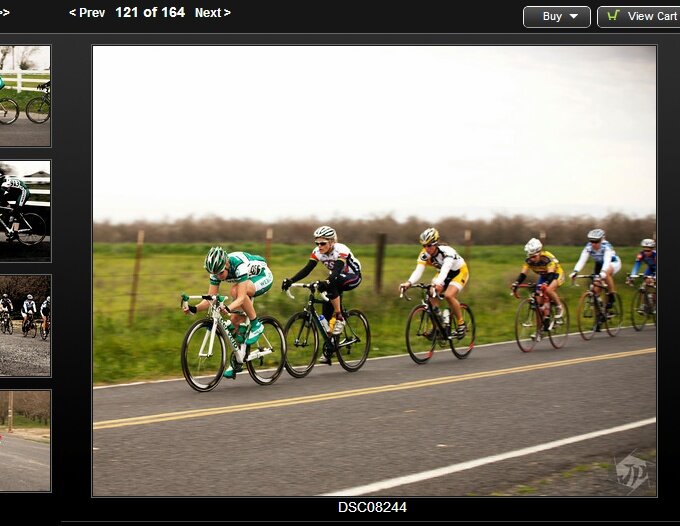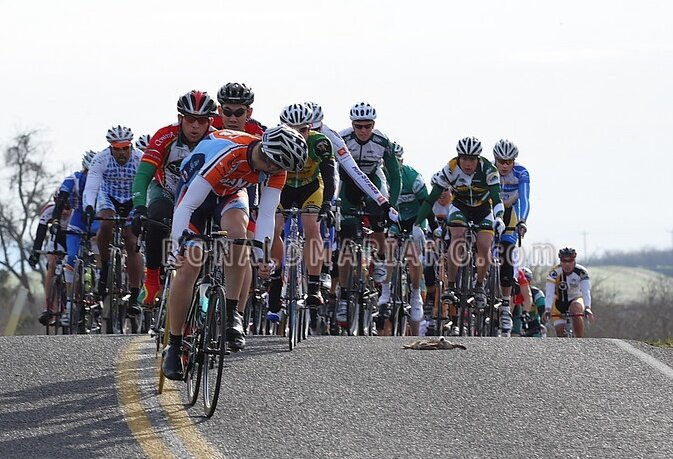Snelling RR … tips & hopes
Snelling Road Race … where all the kids play
With well over a thousand participants already registered for this event, there are some pretty significant issues of logistics that surround a race like Snelling, and they’re worth talking about and sharing. So please feel free to add your own thoughts in the comments section and spread this discussion around to your club&teammates.
Road closure?
 While the course is advertised as closed, we must remember that these are farm roads used by locals who sometimes don’t share the love of bike racing that we all do. In this part of the state, we’ve seen everything from tacks to manure dropped on roads in protest of racing … not to mention the occasional crazy driver who just won’t be stopped from coming on the courses.
While the course is advertised as closed, we must remember that these are farm roads used by locals who sometimes don’t share the love of bike racing that we all do. In this part of the state, we’ve seen everything from tacks to manure dropped on roads in protest of racing … not to mention the occasional crazy driver who just won’t be stopped from coming on the courses.
So, bottom line – even though it’s a closed course, please keep your head up, eyes open, and wits about you at all times.
The best way to stay safe, have fun, and be the most effective on the bike is to be always aware of what’s ahead up the road. The more aware you are, the more you’ll see, and the more time you’ll have to choose the right course of action – be it crash avoidance, preparation for a crosswind, or playing the course to tactical advantage.
.
 Crosswinds … suffering in gutters
Crosswinds … suffering in gutters
While the Snelling course is considered by most as flat … it does have some powerful rollers on it that will sap the snap out legs faster than a tae bo workout. But really, it’s the crosswinds that make most of the pain and separations out in the central valley.
The keys to successfully racing in wind are:
- knowing the course so you can be proactive and preemptive in positioning yourself well for wind changes
- being willing to put yourself in the wind to hold/gain position
- understanding how to use the echelon
- ‘protecting your front wheel’ with good decisions & bike handling skills
- remaining calm and looking ahead
Keyes Road has a mean kick in it after the finishing line for riders as they start laps 2 and beyond ~ but, it also has some very, very fast sections on it afterwards that can cause gaps to form like teeth on a hillbilly. It’s rare that gaps aren’t closed on this road, but with such high speeds possible … it’s a serious waste of energy to have to cross a gap at 30+mph. But, for the most part, Keyes road is a packriding road that meanders up and over rollers often protected a bit by wind.
 The right turn on Olsen Road can often be mayhem … and positioning one’s self near the front can be difficult and cost a lot of energy. Many riders get caught out by this turn because the long section of Keyes Road can lull one into inattention … it can be difficult to remember when/where the Olsen turn occurs.
The right turn on Olsen Road can often be mayhem … and positioning one’s self near the front can be difficult and cost a lot of energy. Many riders get caught out by this turn because the long section of Keyes Road can lull one into inattention … it can be difficult to remember when/where the Olsen turn occurs.
If there is wind, it is likely to cause serious suffering on Olsen Road. The wind often punishes riders by demanding high speeds against sharp winds from the right side of the road. If you find yourself pushed into the left gutter, dodging road debris and praying for just that little bit more draft, you must be prepared to endure bucketloads of pain. But it is those riders who keep their wits about them who will often see opportunities to gain or keep position in the pack. For example, it is common that there will be small moments of respite where riders in the front of the pack turn off the gas, allowing for a slowing of speeds and swelling of the pack – this is not the time for rest, it’s the time for action!
Immediate action when a slowdown occurs can yield tremendous benefits in positioning one’s self in the pack. 10 or 15 pedalstrokes in the wind the moment the pack begins to slow down may be momentarily excrutiating, but the dividends of rest and better positioning yielded by the short effort may be what keeps you in the race, or positioned better to make the winning breakaway.
And lastly, think about keeping the deep dish wheels at home, spendypants. Go with the lower profile stuff if you’ve got it. If you don’t, just remember that wind will push a deeper dish front wheel around quite a bit. Which leads to the concept of ‘protecting the front wheel’ …
 It is common wisdom that the vast majority of crashes in bike racing occur because of over-lapping wheels. But of course the question is … how does one NOT overlap wheels while racing in crosswinds? The answer is … you do overlap wheels in crosswinds. However, you do so with heightened awareness and focus on protecting your front wheel.
It is common wisdom that the vast majority of crashes in bike racing occur because of over-lapping wheels. But of course the question is … how does one NOT overlap wheels while racing in crosswinds? The answer is … you do overlap wheels in crosswinds. However, you do so with heightened awareness and focus on protecting your front wheel.
When overlapping wheels to maintain the draft during crosswinds, it is absolutely imperative that you visualize and act as a flock of birds, or school of fish. If there is movement laterally in the flock, they all move in harmony. It is those who do not act in harmony with the group that will touch wheels and fall down. And so, the keys to protecting one’s front wheels in crosswinds are:
- heightened awareness and focus, look ahead but know that your front wheel is in danger and only YOU can keep it safe
- stay relaxed and fluid, move in harmony with the riders as they move laterally
- try and make no quick or unpredictable movements yourself
Create multiple echelons? … oh, what am i thinking. 2nd and 3rd echelons being formed is something i’ve just never seen done in NorCal racing. Well, maybe one day …
.
Racing in Rain
 This year’s edition of Snelling promises moisture at some point during the day, with the early start waves likely to see more of it than the afternoon. Regardless, water WILL be an issue for racers to deal with, either from the clouds or on the ground.
This year’s edition of Snelling promises moisture at some point during the day, with the early start waves likely to see more of it than the afternoon. Regardless, water WILL be an issue for racers to deal with, either from the clouds or on the ground.
We have to remember that rain does more than just muddy our kits and soak shoes … it also creates and hides the dreaded pothole. This is especially true for central valley roads that have low-grade construction materials and lower-grade fill materials. So please, please keep yourself and others safe by pointing out holes when possible and ALWAYS calling them out!
Remember, just because you heard ‘hole’ doesn’t mean that riders 10 back did … so, please ~ repeat the call for road hazards, even if it seems redundant or retarded. You could, quite literally, be saving somebody’s face from a cheese-grater experience.
Here are some quick tips on racing in rain:
- Fenders, if safely installed, can be a very good way of making friends and keeping one’s back and front a bit less dirty.
- Lower tire pressure ~ I race on 110-115 psi in the best of weather, but for wet conditions will go down to 90-100 psi. For tires like Vredesteins that rate up to 130-145 psi maximum … I’d race dry @ 120 psi, and wet at 105-110 psi.
The reasoning for lower pressure? Improved bike handling. Even though it’s a road race, there are still lots of turns and bumps through the Snelling pastures … and having your bike skip and skiddle over the roads can toss you out of a race faster than a centerline violation. - Start warm and bundled up, but remember that the scorers need to see your race number.
Vests, rain capes, jackets … if you haven’t practiced taking yours off while on the bike … well, dammit you should have been. The temperatures for the morning starts are quite brisk, and you’ll want to be well protected. Some folks favor the use of skin warming embrocations, while others get by with correct layering.
Likely a rain cape will be the best strategy for most who start in the wet. As the speeds pick up, the cape can be pocketed with just a couple of jerseys and arm warmers on for protection.
Tip: food in side pockets, jacket folded in middle. - Remember to eat and drink! Bonking and cramps are very common out at Snelling because of the lack of speed endurance in legs for many in February and the perceived lack of need for nutrition intake. Do yourself a favor and down food every 30 minutes and take constant little sips out of your bottles every 15 minutes.
Lastly, please remember to keep your eyes up the road and absorbing what is happening. It’s especially tempting to stare at the wheel in front of you when the rain and wind are making things miserable … but, the safest thing you can do is look through the rider in front of you and keep your mind attentive and anticipating.
.
Potholes, gravel, dead squirrels … oh my!
 Again, it’s absolutely essential to the safety of all to point out road debris when safe to do so, and always call out road debris. And the key is to remember that if you hear a hazard called out in front of you, to CONTINUE calling out a hazard for those behind you.
Again, it’s absolutely essential to the safety of all to point out road debris when safe to do so, and always call out road debris. And the key is to remember that if you hear a hazard called out in front of you, to CONTINUE calling out a hazard for those behind you.
I can’t tell you how often I’ve seen the front few riders of a pack point or call out a hazard, and then 20 riders back someone crashing right into it because they never heard word or saw signal. Please ~ endure the silliness of the repetition and continue the communication of hazards throughout the entire pack.
The Figmond Avenue section of the Snelling Road Race will be all kinds of Roubaix this year … so, be ready to commit to not only suffering through possible crosswinds on this section, but be ready to have bottles pop out of cages and hands bump off bars from the crapfest road conditions. Stay in the drops, breathe deep, and do your best to remain calm and relaxed when the fit hits the shan.
 Tip: pointing out a pothole may be unsafe. If you end up crashing, or causing one because you hit/swerve something … well, there’s little to do but kick yourself in the butt over it. Again, the best thing you can do is call out “hole” or “cone” or whatever it is that’s going to be coming up and blocked from view for riders behind you.
Tip: pointing out a pothole may be unsafe. If you end up crashing, or causing one because you hit/swerve something … well, there’s little to do but kick yourself in the butt over it. Again, the best thing you can do is call out “hole” or “cone” or whatever it is that’s going to be coming up and blocked from view for riders behind you.
Be safe, be kind, have fun.
.
Passing, or being passed by other fields
This is one of the most challenging aspects of Velopromo road races. The organization attempts to offer as many racing opportunities for all levels of rider … and this has inevitably ended in fields passing one another during events.
Please be aware: there may not be a moto-official to conduct a safe passing of fields … and there is the possibility that a moto-official will make a poor decision as to when a pass takes place.
These are your responsibilities as riders:
- A field that is being overtaken by a faster group MUST NEUTRALIZE AS FAR TO THE RIGHT OF THE ROAD AS SAFELY POSSIBLE.
“Neutralization” means that ALL riders in the pack slow down. I recommend VERY slow – 12-15mph. If you are worried that a breakaway will gain time on your pack as it is neutralized … simply think of the math. If you slow immediately, you will allow space for the overtaking field to pass you safely and get a safe distance ahead of you, allowing your pack to regain speed and initiate chase sooner, loosing less time. - A field that overtakes a neutralized field MUST REMAIN AS FAR TO THE LEFT OF THE ROAD AS SAFELY POSSIBLE, FOR AS LONG AS POSSIBLE.
Do not swerve to the right just because you have passed a neutralized field – you will cause riders behind you to swerve into the neutralized field and increase the chance for accident or fields combining.
Never, NEVER attack just before a field is going to be overtaken. This is the ultimate in douche-baggery. Do not be a douche. - ANNOUNCE and communicate that your field is overtaking, or being overtaken by another field.
Basically, take care of each other.
.
Clear the Finishing Straight
And finally – here’s a nice little golden rule for all to remember and live by:
“Even though your race has ended,
doesn’t mean the racing has ended!”
The Snelling finish is on a narrow road and it is always the case that folks want to watch finishes or chat after their own finish. Please remember to keep the road clear by getting COMPLETELY off the finishing straight at all times.
Just some good ole’ fashion common sense and common courtesy.
- – -
Be safe, have fun, ride fast!
February 25th, 2010 at
Hernanda-Vaj, nice one!! me gusto.
February 28th, 2010 at
amazing post! thanks.
February 28th, 2010 at
Didn’t realize that Mr. Hernandez was a engineer, inspector or a contractor that dealt in road construction. To say that the Central Valley roads have been constructed of low-grade materials is simply not true. They are built of the same materials used in the Bay Area and Coastal region and held to the same building codes.
The Central Valley provides some of the finest road racing in the state. Don’t knock it cause it doesn’t receive the same amount of maintenance funds that your neck of the woods does.
February 20th, 2011 at
Mr Ball,
Are you running for office? Why are you being so critical of Mr Hernandez and his great race report?
February 24th, 2011 at
Seriously Mister Ball – ‘Nando is complaining about the quality of the road surface that races get those free massages from, using material quality as a hyperbolic talking point.
We luvs us the Central Valley and its race courses and wish that those counties could afford to pave more often. But logically, the kinds of roads that have low enough traffic levels to allow partial or complete road closures for racing are consequently low on the repair priority list. much the same thing happens closer in to the Bay area too.
to be honest, I’d rather race on Snelling’s course any day than Copperoppolis’. But part of that may be the contours as much as the road quality.